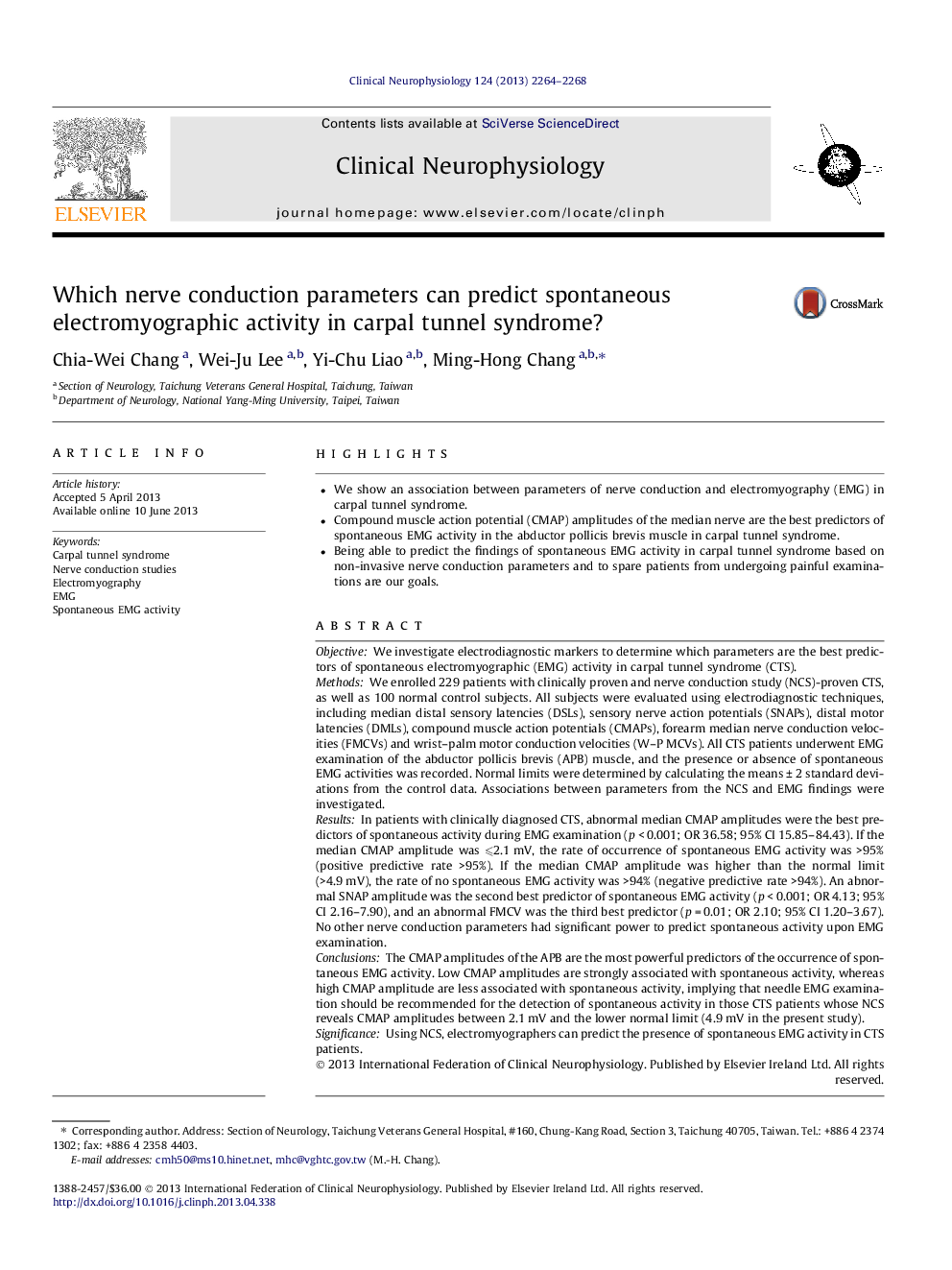| Article ID | Journal | Published Year | Pages | File Type |
|---|---|---|---|---|
| 3043329 | Clinical Neurophysiology | 2013 | 5 Pages |
•We show an association between parameters of nerve conduction and electromyography (EMG) in carpal tunnel syndrome.•Compound muscle action potential (CMAP) amplitudes of the median nerve are the best predictors of spontaneous EMG activity in the abductor pollicis brevis muscle in carpal tunnel syndrome.•Being able to predict the findings of spontaneous EMG activity in carpal tunnel syndrome based on non-invasive nerve conduction parameters and to spare patients from undergoing painful examinations are our goals.
ObjectiveWe investigate electrodiagnostic markers to determine which parameters are the best predictors of spontaneous electromyographic (EMG) activity in carpal tunnel syndrome (CTS).MethodsWe enrolled 229 patients with clinically proven and nerve conduction study (NCS)-proven CTS, as well as 100 normal control subjects. All subjects were evaluated using electrodiagnostic techniques, including median distal sensory latencies (DSLs), sensory nerve action potentials (SNAPs), distal motor latencies (DMLs), compound muscle action potentials (CMAPs), forearm median nerve conduction velocities (FMCVs) and wrist–palm motor conduction velocities (W–P MCVs). All CTS patients underwent EMG examination of the abductor pollicis brevis (APB) muscle, and the presence or absence of spontaneous EMG activities was recorded. Normal limits were determined by calculating the means ± 2 standard deviations from the control data. Associations between parameters from the NCS and EMG findings were investigated.ResultsIn patients with clinically diagnosed CTS, abnormal median CMAP amplitudes were the best predictors of spontaneous activity during EMG examination (p < 0.001; OR 36.58; 95% CI 15.85–84.43). If the median CMAP amplitude was ⩽2.1 mV, the rate of occurrence of spontaneous EMG activity was >95% (positive predictive rate >95%). If the median CMAP amplitude was higher than the normal limit (>4.9 mV), the rate of no spontaneous EMG activity was >94% (negative predictive rate >94%). An abnormal SNAP amplitude was the second best predictor of spontaneous EMG activity (p < 0.001; OR 4.13; 95% CI 2.16–7.90), and an abnormal FMCV was the third best predictor (p = 0.01; OR 2.10; 95% CI 1.20–3.67). No other nerve conduction parameters had significant power to predict spontaneous activity upon EMG examination.ConclusionsThe CMAP amplitudes of the APB are the most powerful predictors of the occurrence of spontaneous EMG activity. Low CMAP amplitudes are strongly associated with spontaneous activity, whereas high CMAP amplitude are less associated with spontaneous activity, implying that needle EMG examination should be recommended for the detection of spontaneous activity in those CTS patients whose NCS reveals CMAP amplitudes between 2.1 mV and the lower normal limit (4.9 mV in the present study).SignificanceUsing NCS, electromyographers can predict the presence of spontaneous EMG activity in CTS patients.
